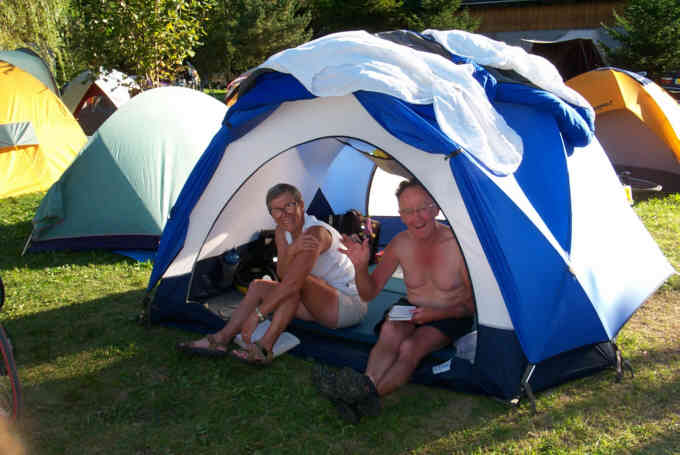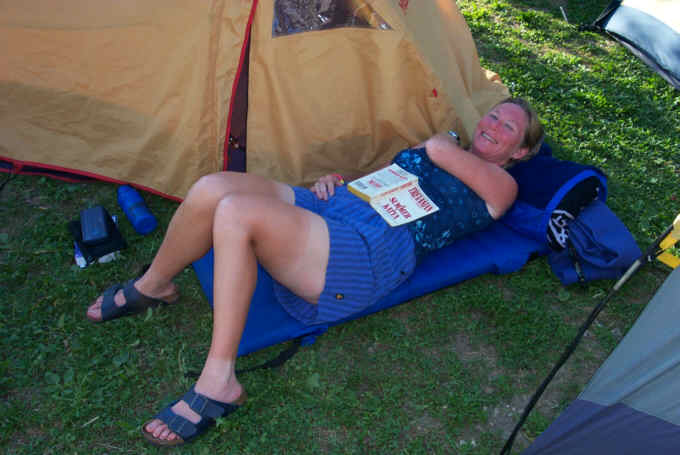

Page 74
Netherlands 
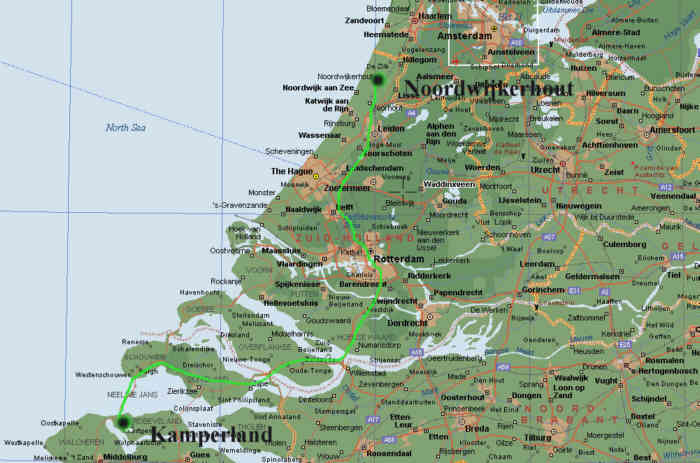
Kamperland to Noordwijkerhout (Amsterdam)
September
8, 2000
It wasn’t until I picked up the eight page DRG that I realized what a long day this was to be. The last that I had heard it had been split into two days but in fact the opposite was planned. It was to be the longest mileage day yet. The weather was undecided, to rain or not to rain. To save time I wore my rain coat, rain pants and boots from the outset. When the rain eased I pushed up my sleeves and rolled up my pants, saving the time required to take them off and put them away. With a boost from a tailwind we made good progress until coffee time. Then we dawdled, visiting an ATM machine, the bakery, and a drugstore where we each bought an armload of necessary things like toothpaste, deoderant and hair color.
One of the highlights of the day was riding across the barriers called the Delta Expo. To the uninformed it would be much like riding across any other huge and sturdy bridge, although one might wonder at the huge cement pillars. Except for Joan, that would have been me. I had left before the mayor’s speech after dinner but Joan had stayed. The mayor had sent his regrets and a letter of welcome so a new program had to be found to take his place and that program was a slideshow about the Delta Expo. It must be one of the great engineering feats of all time. Those enormous bridges have steel panels that can be closed to block out the sea water so that if there is a terrible storm with high seas the barriers can be closed preventing flooding and devastation in Holland.
Holland is crisscrossed with bicycle paths which we rode on most of the day. They are paved and often detached from the road making them feel quieter and safer. The Dutch make good use of the paths, according to some sources there are more bikes than people in Holland but whether or not that is true, there are more bikes and people riding bikes in Holland than any country we’ve visited. School children ride them, mothers picking up or escorting children ride them, shoppers ride them, commuters ride them, grandmothers and grandfathers ride them. There are hundreds and thousands of bicycles parked and locked in racks at train stations. The most common bicycles have very upright handlebars and no gears. Women have bikes with low top bars, the kind we called a ‘girl’s bike’ when I was young. There is a protective shield over the rear wheel and the chain so that clothing cannot become caught or get dirty. They can be seen cycling in beautiful clothes including flowing dresses and fancy shoes, and step on and off their bikes with ease and elegance. Men ride bikes with straight top bars and high handlebars. They are often seen peddling along while apparently at rest, arms are folded and resting on the handlebars. Other men ride with one hand resting behind their backs and teenagers ride with a phone in one hand and maybe no hands on the handlebars. Parents of very young children ride a bike with a windshield and a child’s seat fitted to the front so that the child is directly in front of the parent. The windshield helps protect the child from wind and to some extent, rain. No one wears a helmet.
In Rotterdam some riders became confused and lost their way. We might have been among them but at the moment of our indecision along came Bill Bliss. Joan said, “Bill never gets lost. Let’s follow him.” And so we did. I tried to read the DRG while following Bill and in no way would I have made the same decisions as Bill did. How he could read what was written and then guess so accurately what action was needed will always be a mystery to me. He led us out of Rotterdam without a moment’s hesitation and without error. Bill is one of the seven who have ridden every mile, and not only that but he has ridden every mile that was originally scheduled rather than taking advantage of a bus or a train ride when TK&A provided it because they had revised the itinerary. On the contrary, Bill has even ridden on layover days, taking side trips to see more of the countryside. When someone was overheard grumbling about the rain Bill simply observed, ‘Cycling is an outdoor sport.’
Rotterdam was a surprise to me. I was stunned by the daring architecture of a few modern buildings I could see while enroute and longed for a better look at the canals and the old buildings alongside them. The harbor was a busy place with boats and ships coming and going. Later I learned that Rotterdam is the largest port in the world, 40,000 ships a year dock there while by comparison only 3000 go to Amsterdam.
But we didn’t dare to stop or we’d lose sight of Bill so we cycled on, not stopping for even a single picture. In fact I didn’t take a picture the whole day, not even of the famous windmills because of the rain and the mileage that allowed us no spare time. Late in the afternoon with still 40 or 50 kilometers to go, Joan and I found we were both in the same mood, finish the ride or die trying! So we hunkered down and just pedaled, finally stopping only when we thought we were lost. It was getting too dark to read the signs but we were too close to give up. We took a wrong turn on a trail that led us into the boonies, where we found a Dutch gentleman who offered to show us the way to the campground. He rode at a snail’s pace and as it turned out, he didn’t know the way either. But he did know the general direction and the language and by stopping and asking he helped us find our way. It was about 8 p.m. when we finally arrived at Jan De Wit Camping. We thought we’d win the naked rubber chicken for sure (given each day to the last rider to finish - although what the significance of a chicken is I do not know and I think it a mean thing to do) and had decided to share it by splitting it down the middle from beak to tail. I was going to chop my half into little bits and throw it away. Not that that would help. One rider lost the first chicken but it was soon replaced by another.
It had rained on and off all day and it was raining at the campground, unfortunately. Joan had had the foresight to ask Kay, a rider with a car who was driving directly to the end of day to find a room for her if possible. She had. There was a note for Joan on the sign-in sheet. Her room was in the hostel where we’d be having our meals, only 500 meters or so back down the road. We’d passed it earlier but couldn’t stop to eat because we hadn’t signed in, and because I wanted to pitch my tent before dark. Joan took the things she’d need for the night and left for the hostel, apologizing for her good fortune and promising to ask if there was room for one more. I pitched my tent in the rain and just as I was finishing word came back that there was room for me at the inn! My tent was up but it was wet inside as well as out so I decided on the hostel and left the tent standing in my haste to get to the hostel for dinner. There were a few elbows of cold macaroni left in one tray and a little greasy cold sauce left in another. By now everyone else had eaten and left. But before I had finished a few more stragglers arrived. They had resorted to walking when it became too dark to cycle. I don’t know who was awarded the rubber chicken that day but anyone who finishes 175 km. ought to be congratulated not teased.
Goodbye,
Alice
Noordwijkerhout Layover Days
September
9-12, 2000
I’m not sure how it happened that so many layover days were planned for Amsterdam but as it turned out I certainly appreciated them. The original intent was that we would be staying in the city of Amsterdam but TK&A was unable to find lodging for us there so instead rooms were booked about an hour and a half away by bus and train near a village called Noordwijkerhout. It was a strange arrangement though. The day we cycled the 175 km. to Noordwijkerhout was a camping night at the Jan De Wit Campground. The next two nights were in the Leeuwenhorst Golden Tulip Conference Hotel just a few kilometers away, followed by two nights back in the campground and finishing with one last night back in the same hotel. No one liked the idea of going back to the campground for two nights in the middle of the hotel nights. I never learned whether that was an economy measure or whether there weren’t enough rooms available for us. To make it a little less annoying, we were told that we could leave our tents standing in the campground for the two nights we were in the hotel. But many people made other plans.
I didn’t camp at all. I had pitched my tent, but then spent the first camping night in the hostel instead. On Day 253, the first layover day, I took my wet tent to the hotel with me where I washed and dried it, ready for the flight to Australia. I spent two days hand washing every dirty thing and sorting and reorganizing. An awful job. But I had some very good luck at that hotel. I hadn’t arranged to be anyone’s roommate, it was to be just two to a room, a real luxury, so when I checked in I was asked if I would be Margherita’s roommate. That was fine with me, I said, but as I hadn’t ever roomed with her I didn’t know whether my snoring might bother her. They told me to check, and sure enough Margherita said it would be annoying, she’d rather not have me for a roommate. So I was assigned to an empty room and my great good fortune was that it remained empty! Yes! All that space to myself! It was grand. I messed up the whole space with my stuff and lay in bed late the first night watching the movie, ‘Sense and Sensibility’ for free on television which I greatly enjoyed.
The second evening about 50 of us traveled by chartered bus to Maryke’s brother’s restaurant, the De Klink, for a grand dinner. It was about a two hour ride through the very flat countryside. The driver reminded us that the Dutch had reclaimed land from the sea and that we were traveling on newer land which would explain the absence of big trees and old buildings. With that brought to our attention it was easy to know when we were back on older land. The De Klink restaurant faced a wide canal and was beside a yacht harbor so that it had a beautiful setting. We could see fish jumping, swans gliding past and the sun setting. It was a lovely evening.
Meanwhile plans were hatching for the next two days. It seemed a shame to be so close to Amsterdam and then miss it so ‘Dr.’ Sharon (Wolfe) and I made plans to go there for one night which would give us the best part of two days to explore. She called and reserved beds for us at a hostel which calls itself a budget hotel, the Tourist Inn. By the time we left Judy Montague had joined us. We traveled by bus and train and on arriving in Amsterdam stopped at the upscale Victoria Hotel for coffee and a slice of ‘appeltaart met schlag’, (one crust deep apple pie with whipped cream). We walked then to the Tourist Inn where we left our things in a storage closet and set off to see Amsterdam.
We started with a canal cruise that stopped frequently, letting people on and off to visit museums. Our first stop was the wonderful Van Gogh Museum and after looking at more than 200 of his paintings which were displayed chronologically, my favorite is still the bright, cheerful painting of his Bedroom at Arles. One of the remarkable things about Van Gogh was that he made more than 800 paintings and more than 1000 drawings in only ten years.
The next day we visited the Rijks Museum which is so huge I chose to visit only the special exhibit, The Glory of the Golden Age. There were 200 of the most beautiful works of art of the Dutch Golden Age displayed along with sculptures, furniture, and decorative objects which depicted Holland’s prosperity in the 17th century. The paintings were arranged in 23 galleries and a printed guide was prepared that made the tour easy and enjoyable. The galleries were identified with Roman numerals and a paragraph in the front of the guide briefly explained the theme of each gallery. Each painting was numbered so that it was easy to locate the background information about it in the guide. One could choose to read about the paintings that caught the eye and walk past the others.
After lunch we went to the Anne Frank Museum. The top floors of the house where Anne and her family hid have been preserved as a museum. It is small and close, hot and stuffy, giving us a bit of a feel for what it might have been like to be confined there, ‘suffocating’, to use Anne’s word. She kept a diary while living there and that helped her to survive the ordeal. On March 16, 1944 she wrote, ‘But, still, the brightest spot of all is that at least I can write down all my thoughts and feelings; otherwise, I’d absolutely suffocate.’ When their hiding place was discovered and the Nazis took them away, the Nazis also took all the furniture and other belongings. Just by accident Anne’s diary and her edited version of the book she had written while in hiding, ‘The Secret Annex’, fell to the ground and was overlooked. It was retrieved later in the day by friends and preserved, to be given after the liberation of the camps to her father, Otto Frank, the only one of the eight who had hidden in the annex to survive the concentration camps.
Our time in Amsterdam flew as it always does when having fun. The Budget Inn was just inside the area known as the ‘red light’ area so we couldn’t miss that unique attraction. The lights are indeed red and the women are beautiful and friendly, waving to us as we blatantly gawked at them. Police on foot patrolled the streets, it seemed as safe as anywhere, and not at all seedy.
When we returned by train and bus to Noordwikjerhout we walked from the bus stop to the Golden Tulip Hotel where we had left our bikes. Judy had decided to take a room in the hotel for the night, but I had a reservation at the hostel and Sharon was going back to her tent which was still standing in the campground. It was a campground night but since I had already cleaned and dried my tent in preparation for the flight to Australia, I didn’t want to use it. The hostel was an easy and inexpensive option and convenient too for that is where our meals would be served. Sharon and I loaded our bikes with all of our gear and pedaled to the hostel where we arrived just in time for dinner. Hostel meals tend to be marginal at best because they are planned with economy in mind. This meal was almost entirely vegetables, a welcome change for us. There were mashed potatoes with carrots and mashed potatoes with broccoli and two or three other variations of mashed combined vegetables, all nicely seasoned and typical Dutch cooking I think because I have seen similar looking preparations displayed for sale in delicatessans. Most of us are sick to death of the mainly meat meals we are usually served but since our menu is always set we are stuck with it.
My roommates for the night in the hostel were Joan and Gudrun and as I was the latecomer, I had a top bunk. They are fine roommates, but the other guests on our floor were scores of middle school students who spent most of the night running and screaming and slamming doors. They ruined my sleep. In the morning I wanted to take my revenge while they slept but I restrained myself. Instead I packed my belongings back into my bike bags, pedaled to the campground to leave most of those things in my locker, and refilled my bags with the papers, books and other odds and ends I wanted to mail home. Then I cycled to a store with camping products where I bought two cans of waterproofing spray for my tent and waterproof bags to protect my sleeping bag, etc. I am anticipating a lot of rain in Asia. I did more shopping, made two trips to post offices to get everything mailed, and had my hair cut. While waiting for my haircut I treated myself to the best ever slice of warm apple tart with whipped cream and a cup of coffee.
With my errands completed I had to return to the hotel and get to work. This was the last day to get ready for the flight and I was running out of time. I rushed to set up my tent so that I could spray it to waterproof it. This time I sprayed the entire ‘bathtub’ part of the tent itself which had leaked during a severe rainstorm during the first night in the Jan De Wit campground. Luckily nothing was in it. I also sprayed the part of the fly missed before when I didn’t have enough spray to cover it completely.
That done I had to do the most yucky job, clean my bike. I had good company, many other riders were doing the same, all of us sharing one hose. Sand and mud were stuck to our bikes from riding in the rain and it was hard to get rid of it all. Cleaning the chain and drive train is really dirty work but not so bad for me because I use Pedro’s Ice Wax as a chain lubricant which prevents a build up of gooey black grease. I can’t see why everyone doesn’t use it. We had to do all this scrubbing and cleaning because we’d been told to. Apparently it is necessary to be squeaky clean to pass inspection on entry to Australia. We were told that dirty tents and bikes would be confiscated and kept until they could be fumigated. I’ve had experiences that make me wonder if they shouldn’t be anyway. At various times little animals have taken a ride on my bike, a spider moved right in and spun a web under my water bottle cage for example, and another time a snail took a ride on my rear rack under the trunk bag where it was hidden. We often find critters in our tents the next night when we unfold them to set them up. Snails and slugs are common stowaways as are grasshoppers, earwigs, and all sorts of flying insects. But that is to be expected as the tents are quickly taken down and rolled up wet, any unsuspecting insects, grass, mud, etc. included. Imagine my surprise when I unrolled my squeaky clean tent to spray it with waterproofing and a big black beetle walked out of the folds. I had washed that tent both outside out and inside out in the bathtub, rinsed it, hung it to dry in the shower, turned it right side out, carefully inspected it, and zipped and folded it before putting it away in its clean stuff sack. Where did I get the beetle?
Goodbye, Alice
Today's Music
These Boots Are Made For Walking
Netherlands 
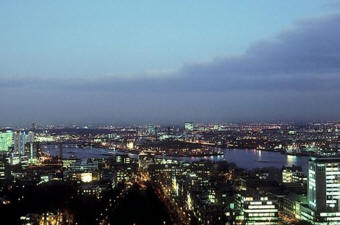

World’s Largest Port at Rotterdam (Left)
Rotterdam, the world’s largest port and the second largest city in The Netherlands, spreads out across the Nieuwe Maas, an estuary of the Rhine. Two other rivers, the Waal and Meuse (or Mass), flow through the southern part of the city from Germany and Belgium, respectively. Rotterdam is connected to the North Sea by the Nieuwe Waterweg, a canal that allows large seagoing vessels access to its immense harbor. Nearly 300 million metric tons of goods travel through Rotterdam harbor annually, and the port industrial complex along the Rhine delta also includes oil and petrochemical refineries.
Parliament of The Hague (Right)
The Hague is the seat of government of The Netherlands and the official residence of the monarchy. The Parliament buildings stand in the heart of the old section of The Hague. Next door is a museum that contains the largest collection of Rembrandt paintings in the world. The city’s magnificent Peace Palace was built in the early 1900s. It houses the Permanent Court of Arbitration (PCA) and International Court of Justice (ICJ).
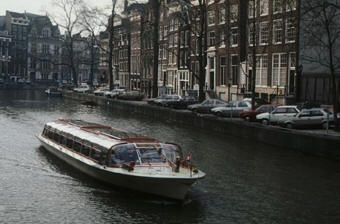
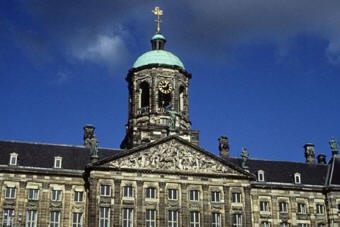
Dutch Center of Commerce (Left)
For
centuries, the canals of Amsterdam comprised the trading hub of The Netherlands.
Wealthy merchants lived and worked in the large early-17th-century houses lining
the canals. Hazardous or foul-smelling industries were prohibited in the area.
Most of these steep-roofed dwellings are now hotels, offices, and banks.
Amsterdam’s Royal Palace (Right)
Amsterdam’s 17th-century Koninklijk Paleis, also known as the Royal Palace or Dam Palace, has earned the nickname “Eighth Wonder of the World” because of its unusual construction. The vast structure on Dam Square was built atop 13,659 wooden piles that were driven into the marshy soil to hold it in place. Inside the palace are the renowned van Helt Stockade allegoric ceiling paintings and a regal decor by leading artists of the 1800s. Dam Square sits at the point at which the Amstel River was dammed in the 13th century, giving Amsterdam its name.
Switzerland ![]() France
France ![]()
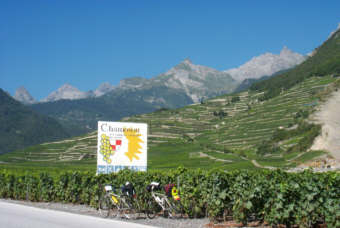
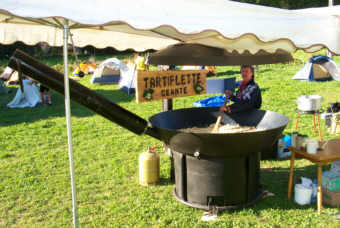
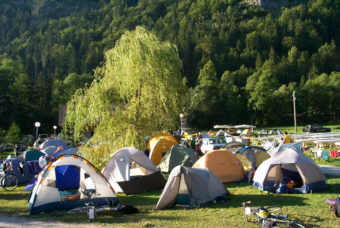
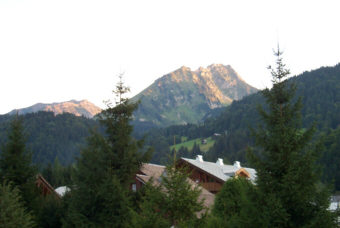
Switzerland, France (Day 238, Page 68)
 Odyssey Riders and Staff
Odyssey Riders and Staff
